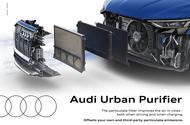Audi’s Urban Purifier promises to clean the air dirtied by a combustion engine in one cycle
Attached to the front of an E-tron, Audi’s system traps dirty particulates for a cleaner environment
Several manufacturers, including Toyota and Hyundai, have tinkered with the idea of using the car as a mobile vacuum cleaner to hoover up particulates from the atmosphere, and now Audi is the latest to dip a toe in the water.
In conjunction with supplier Mann+Hummel, it has begun trials of the Audi Urban Purifier particulate filter, installed ahead of the radiator of an Audi E-tron. The filter is fed via the switchable air cooling inlet of the E-tron and is designed in such a way that particulates become trapped while enabling air to continue flowing through it in sufficient volume to allow the radiator do its job.
The project will run until 2024, but test vehicles have completed 31,000 miles of endurance testing to establish the size of the filters and their effectiveness. The new tech has no impact on range or the drivetrain, even on hot days and during charging, when temperature control is vital to the well-being of a powerful EV battery being force-fed by an ultra-rapid charger.
The filter system traps the finest PM10 particulates (measuring 10 micrometres, or 0.01mm). These (and smaller) are the same size as the diesel particulates that all the fuss was about. But particulates of that size with a different chemical make-up are created by brakes, tyre wear, wear of the road surface and older engines, especially those without particulate filters.
So far, the filters have proved capable of extracting 100% of the particles that pass through them. Like other filters on a car, this one needs replacing only at regular service intervals, and computer modelling suggests that over the entire lifecycle of the filter system, it will collect 14.9kg of dust.
Mann+Hummel had been working on the idea on its own initiative prior to the joint project. EU figures for 2016 published by the company show that of all traffic-related dust, 27% is due to brake wear, 28% tyre wear and33% road wear, but only 12% is due to exhaust emissions.
The company has already trialled a filter system that can be mounted to the roof or underside of commercial vehicles and, like the Audi system, uses fans to circulate air through them even when the vehicle is stopped in traffic. The evidence from the trials using the firm’s Fine Dust Eater test vehicles shows the filters trap as many particulates from the air as a modern petrol or diesel engine emits during the combustion process in the same time.
An alternative is a brake-dust filter that collects brake dust at source. It consists of a casing straddling the disc and mounted directly behind the calliper and acting, quite literally, as a dustbin. As the disc spins, brake dust generated by the wear of the brake pads and through disc wear is scooped up into it and collected.
Testing so far under real driving conditions has shown that the filter retains 80% of the particles the brake generates, rather than allowing them to be spewed freely into the air. In production, engineers say they’re confident the filter-cleaning interval will correspond with the service interval of the brake pads.
Citroën’s sustainable tyre
Citroën’s interesting Oli concept car, revealed at the end of September, goes about its business on Goodyear GO concept tyres made from sustainable materials. Sunflower oils and pine-tree resins replace petroleum-derived materials; responsibly sourced natural rubber replaces synthetic petroleum-based rubber; and rice husk ash silica from rice-processing destined for landfill is used in the carcass of the tyre.
Source: Autocar
